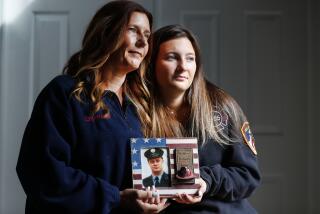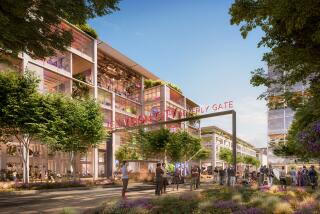Political Friction, Victims’ Families May Block Plans for Trade Center Site
NEW YORK — After months of bitter wrangling, parents will finally send their children back to classes this morning at the last public school to reopen near the site of the World Trade Center in lower Manhattan.
Just before noon, a popular clothing store damaged in the attacks will reopen near ground zero, welcoming back thousands of loyal customers.
And by late afternoon, families of victims in the attacks will meet for the first time with the panel planning the redevelopment of the area and the construction of a temporary memorial for those who perished.
On the surface, life is moving forward in a community that was devastated on Sept. 11. But behind the scenes there is acrimony among business leaders over what should be built at the site, growing political friction at City Hall and grass-roots discontent that could block any new construction here for years.
These might be serious problems in other cities, but in the Big Apple they are unmistakable signs of the healing process. United in numbing grief for nearly six months, New Yorkers are throwing sharp elbows once again, trading blows over the recovery and rebuilding of their city.
“This is a tough town to get anything built in, a hard place to reach any kind of consensus,” said Marilyn Taylor, who chairs Skidmore, Owings & Merrill, a prominent architectural firm involved in the planning debate. “But we have to do that in lower Manhattan, because in terms of new development possibilities, we may have the opportunity of a lifetime.”
Above it all looms Larry Silverstein, the developer who holds a 99-year lease to the World Trade Center site and is eager to rebuild his $3.2-billion prize as quickly as possible. Gov. George Pataki encouraged him to move quickly on an initial phase of construction, then urged caution. The development panel gave him mixed signals. On Tuesday, New York Mayor Michael R. Bloomberg told Silverstein to slow down while a blueprint for the whole area is worked out, setting up a protracted wrangle over the 16-acre site.
“I would recommend stalling a little while longer,” the mayor said, all but derailing Silverstein’s plan to quickly rebuild World Trade Center Building 7, a 47-story structure he owned near the site that collapsed after the twin towers fell. “I think over the summer you’ll see people sitting down and looking at a more comprehensive plan,” Bloomberg added.
Few observers are surprised because this is a city where big construction plans face inordinate hurdles. New York spent 20 years wrestling with an ambitious plan to build a superhighway down Manhattan’s west side, for example, but the project grew to boondoggle proportions and then collapsed amid a flurry of lawsuits, neighborhood protests and political delays.
In most other communities, Silverstein would be in the driver’s seat. He’s got prized land to develop, money to burn from a $3.4-billion insurance settlement and a gung-ho spirit. Although he has yet to reveal his blueprints, the 70-year-old businessman is expected to promote a plan with several towers of varying height, a large mall and a victims’ memorial.
But he’s just one more voice in New York City, where some victim groups are threatening to stage acts of civil disobedience at ground zero if bulldozers break ground to erect any commercial or office structures.
The developer was unavailable for comment, but his spokesman, Howard Rubenstein, said with a sigh: “Mr. Silverstein is willing to be patient, until everyone else involved in this process is ready to move forward.”
Judging from the debate so far, that could take months, if not years.
Some fear that new construction might aggravate existing air pollution problems in the area, given the varying levels of asbestos and lead that have been monitored indoors.
Sharon Sprague, who was until recently the head of the PTA at PS 89, said most parents are glad that students will return to classrooms today. But Sprague and others are not convinced that the air is safe. With reluctance, she decided to send her children to another school.
“It was a hard decision, made for a lot of complex reasons,” she said. “While we don’t believe the air inside the school is dangerous to the children, we certainly didn’t get all of the reassurances we needed.”
The decision to return children to the school was rushed, she said, “and I really don’t see the need for all of this rushing in lower Manhattan.”
For local business leaders, however, the city can’t move quickly enough to restore economic growth. There were an estimated 100,000 jobs lost in the community after the attacks, and more than 20% of the estimated 25,000 residents left their homes, said Julie Menin, founder of Wall Street Rising, a new nonprofit group trying to spur economic activity and tourism in the area.
“We’re seeing some signs of life here,” she noted, “but it’s very slow.”
While tourist activity has picked up in the area, many restaurants are still suffering a significant fall-off in business. Business leaders hope that the recent opening of a glitzy Ritz Carlton Hotel near Battery Park City will lure more visitors, along with plans to host a TriBeCa Film Festival and an art gallery festival in and around the Wall Street area.
They are also looking forward to today’s reopening of the Century 21 discount clothing store, which was one of the more popular shopping sites in the trade center area.
Last week, state officials unveiled plans to develop more than $200 million in rent subsidies to keep residents in lower Manhattan. Depending on how close they live to the trade center site, some families might be eligible to receive as much as $12,000 in onetime housing grants.
“Those are the short-term things we need to do,” said Menin, whose group is sponsoring a new discount card that will offer visitors lower prices at restaurants, galleries, theaters and other local businesses.
But in the long run, she added, nothing will jump-start the economy like new construction at the World Trade Center site. Every day, new ideas for development of the site pour into the Lower Manhattan Development Corp.’s offices. This week, for example, Rebuild Downtown Our Town, a coalition of citizens, business and professional groups and property owners, released a white paper calling for moderate growth.
Dismissing Silverstein’s plans for quick construction, the detailed report said the recovery of bodies remains the top priority at ground zero: “Plans must recognize that the World Trade Center site is a hallowed, sacred burial ground, which must be a peaceful, serene place to mourn. It is not simply a development site. Construction should be minimized.”
Yet those who call for a memorial on much of the site are still thrashing out the details. Should it be a huge, soaring structure, along with a museum, as former New York Mayor Rudolph W. Giuliani has suggested? Or should the memorial be more modest in scale, as many architects recommend?
Bloomberg, flanked by victims’ families, announced Wednesday that two beams of light will rise from near the World Trade Center site as a temporary memorial to victims of Sept. 11. The “Tribute of Light” will run from March 11 to April 13, said Marian Fontana, president of the Sept. 11 Widows’ and Victims’ Families Assn.
But plans to erect another temporary memorial have sparked controversy. Last week, a coalition of victim groups approved the idea of locating a shrine in Battery Park, a few blocks from ground zero. The proposed glass sphere would memorialize all who died on Sept. 11, as well as the six people who perished in the 1993 attack on the World Trade Center site.
“I think we can move forward on the plan for a temporary memorial,” said a source close to the negotiations. “But this is New York. It’s hard to get things done here. The whole plan could change in a heartbeat.”
More to Read
Sign up for Essential California
The most important California stories and recommendations in your inbox every morning.
You may occasionally receive promotional content from the Los Angeles Times.










